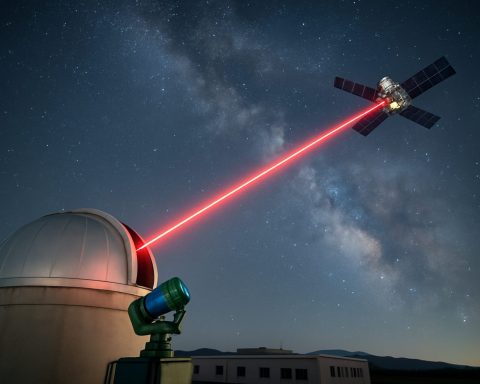- Nut, the Egyptian goddess, is symbolically linked to the heavens and depicted in ancient tombs and temples as a cosmic figure.
- Astrophysicist Or Graur’s research examines 125 images from ancient sarcophagi, suggesting that some depict the Milky Way’s Great Rift.
- The Great Rift is a dark band of cosmic dust running through the Milky Way, potentially seen by ancient Egyptian artists.
- Graur’s findings highlight a potential connection between Egyptian mythology and astronomy, revealing shared stellar themes across cultures.
- These discoveries invite modern viewers to explore both artistic and scientific interpretations of the cosmos, unifying ancient and contemporary perspectives.
- Published in the Journal of Astronomical History and Heritage, Graur’s study emphasizes the multidimensional narrative of Nut’s celestial depictions.
Under the vast Sahara’s eternal sky, legends whisper tales of the Egyptian goddess Nut, her shimmering form sheltering the earth with outstretched limbs. For thousands of years, Nut, the celestial dome, has embodied the boundless heavens in ancient Egyptian tombs and temples. Yet, recent studies suggest that some portrayals of Nut might hold a long-hidden secret—a cosmic bridge to the Milky Way itself.
Astrophysicist Or Graur embarked on a riveting quest, poring over 125 images across 555 ancient sarcophagi, to uncover a celestial mystery. The art scholars and astrophiles alike are abuzz with the tantalizing possibility that Nut’s starry silhouette cradles more than just celestial symbols. In a few rare depictions, a gentle curve slices through Nut’s cosmic canvas, possibly hinting at the Milky Way’s Great Rift—a shadowy seam woven with cosmic dust that cleaves the gleaming galactic band.
Graur, whose endeavors span the University of Portsmouth and the American Museum of Natural History, proposes this: the undulating line may echo the Great Rift—a celestial path mirroring our galaxy’s dark spine. Contrasting these illustrations with modern images of the Milky Way reveals uncanny resemblances, suggesting that ancient watchers of the skies might have perceived the universe with an artist’s eye.
Beneath Nut’s eternal arch, the Earth god Geb rests serenely, as Nut swallows the sun each night and births him anew each dawn. This ceaseless dance illustrates a perfect harmony, immortalizing the sun’s journey as seen by the ancients. Her form, often adorned with stars, mirrors the midnight vistas of our world—twinkling ancient interpretations of the cosmos above.
While the proposition stirs intrigue, Graur remains cautious. Nut, ever the enigmatic deity, is depicted variably, sometimes devoid of this mystical curve, reminding us that her celestial stories are multifaceted. The Milky Way’s symbolic echoes across cultures offer a tantalizing glimpse into our shared stellar heritage through the lens of Egyptian art.
Graur’s findings, detailed in the Journal of Astronomical History and Heritage, present a fascinating overlap between the worlds of mythology and astronomy. Like the ancients gazing at the heavens, we continue our quest for cosmic understanding, tracing it back through centuries of celestial curiosity. The story of Nut invites us to ponder whether her ancient sky might indeed shelter the shimmering road of stars—our galaxy’s Milky Way—captured in timeless art, uniting past and present in a universal dialogue etched in stone.
Did the Ancient Egyptians Capture the Milky Way in Their Art?
Unveiling Cosmic Connections: The Art and Astronomy of Egyptian Goddess Nut
The ancient Egyptians have left us with a rich tapestry of art and mythology, and among these fascinating creations is the goddess Nut, a celestial figure who dominated their understanding of the sky. Recent research has prompted us to reconsider some depictions of Nut, speculating that they may represent more than mere celestial imagery. These portrayals might actually hint at an ancient awareness of the Milky Way, specifically its unique feature—the Great Rift.
The Egyptian Pantheon and Celestial Phenomena
Nut’s iconography is deeply intertwined with that of Geb, the Earth god, creating a compelling narrative of cosmic balance. According to Egyptian mythology, Nut and Geb are separated by Shu, the god of the air, symbolizing the division between the heavens and earth. Nut’s swallowing and rebirthing of the sun each day signifies the cycle of life and death, reflected in the cosmos.
How the Great Rift Aligns with Nut’s Imagery
Astrophysicist Or Graur’s analysis of over 500 sarcophagi reveals certain depictions where a peculiar curve might signify the Milky Way’s Great Rift. The Great Rift is a series of dark dust clouds obscuring part of the Milky Way, creating a visual seam in the galactic plane. This astronomic feature might have also been visible to ancient Egyptians, inspiring its depiction in Nut’s heavenly form.
Implications in Astronomy and Mythology
Nut’s representation emphasizes the intersection of astronomy and mythology, suggesting that ancient people might have had an understanding of astronomical phenomena that parallels our modern interpretations. This raises intriguing questions about the commonalities shared across cultures in recognizing and representing the Milky Way in their own mythological lexicons.
Pressing Questions and Expert Insights
Could other ancient cultures similarly perceive the cosmos? Many cultures have storied histories of integrating celestial phenomena into their myths. The Greeks, for example, personified stars and constellations through their deities, attributing mythological stories to entities in the sky.
Why is the Great Rift significant? The Great Rift has always fascinated astronomers due to the dust clouds that obscure and divide the Milky Way, enhancing its mysterious allure. Its presence in art could suggest a more profound historical appreciation and observation of the night sky.
Future Research and Discoveries
How can modern technology help us understand these ancient portrayals? Technologies like spectral analysis and high-resolution imaging can allow researchers to study the specific pigments and materials used in ancient art, possibly linking them with cosmological references.
Actionable Recommendations for Skywatchers
1. Explore the Night Sky: Familiarize yourself with the Great Rift by identifying it in the Milky Way. Use a star map or apps like Star Walk to guide you on a cloudless night.
2. Visit Ancient Sites: Plan a visit to museums or archaeological sites that feature Egyptian art, particularly those depicting Nut. Seeing these images firsthand can provide a deeper appreciation of their cosmic significance.
3. Learn Constellation History: Broaden your understanding of how ancient civilizations interpreted the stars by studying different mythologies and their celestial interpretations.
Conclusion: A Celestial Legacy
The uncovering of Nut’s potential depiction of the Milky Way invites a renewed admiration for the ancients’ conceptual outlook on the universe. As we delve into this cosmic dialogue woven into stone, we are reminded of our enduring connection to the stars and the eternal quest to understand our place within the cosmos.
For more information on archaeology and astronomy, visit National Geographic.












